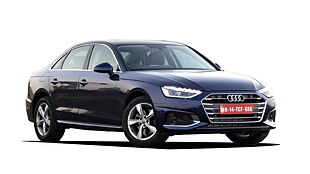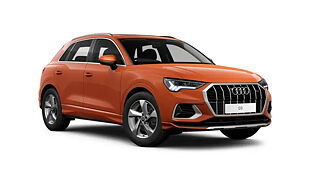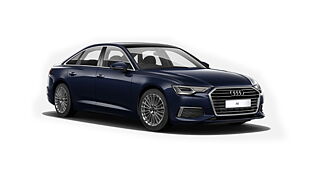Introduction

Let me admit that I wasn’t really looking forward to driving the petrol Q5. After all, even if you are a person with enough money to drop on a car that costs as much as a house in the far-flung suburbs of Mumbai, you’d still want the performance *cough*efficiency*cough* of a diesel to shift all that weight. But the first time I put my foot down in the new 2.0-litre Audi Q5, I suddenly got interested. What makes this petrol SUV so good, then?
Looks and design

The looks have been refreshed – that is evident, especially at night. The daytime running lights now outline the entire headlamp unit instead of being just “eyebrows” like the outgoing one. The grille is now prominently chromed, and the emphasis is now on vertical lines. The wheels also have a nice new design, but they are too reminiscent of the Honda City/Brio’s alloy wheels. Of course, they are Gulliver-sized compared to the Lilliputian Honda wheels, but the similarity is there. The tail lamps are now modelled after the Q7’s lamps and if you didn’t know better, you’d mistake it for the larger model at night. A good thing, since the Q7 seems to be the SUV of choice for tinseltown in India as well.
Interiors

The interior is the same airy space as before, with a few incremental changes. There are chrome and wood accents, the steering wheel is now one specific to the SUV lineup, and the MMI controls have more buttons than before. Everything else remains the same as before – and special mention must be made of the front seats; with the levels of adjustment on offer, they are so comfortable that even our picky testers loved them no end. There is no space for an optional third row, and neither has Audi given an option of anchor points should you want one, like BMW has with its similarly-priced X3. You might also find the Q5 short on the audio system front: make no mistake, the system is really very good, with a most interesting subwoofer placed in a plastic cabinet housed inside the space saver under the boot floor – but you can either play a disc, or insert two SD cards. In this age of iPod and Bluetooth connectivity, a range of options to play your music off will certainly be appreciated. The satellite navigation is a welcome addition, and the number of points of interest included in the map is amazing.
Engine and performance

What has been updated in a major way is the powertrain: the 2.0-litre petrol now has 225PS and 380Nm, 14PS and 30Nm over the previous engine. Audi says it has managed this with an updated fuel injection system, turbocharger and by integrating the exhaust manifold in the cylinder head. The really big news is the eight-speed automatic gearbox – it allows a claimed 7.1 seconds to 100kph from a standstill, which is plenty quick by Indian standards, and the ability to cruise at 80kph at less than 2000rpm, a rarity for a 2.0-litre petrol. The ARAI efficiency is 9.74kmpl, which isn’t too bad considering the weight of the car. The Q5 also gets auto start-stop as standard, so it saves fuel while you’re stopped in traffic without the annoying side effect of the air-conditioning or audio system switching off and then back on when the engine is started automatically. The diesels retain seven-speed gearboxes thanks to their better torque. Another small change is the switch to “S” sport mode from the regular “D” mode; tipping the gear lever back toggles between D and S modes, unlike before where S was a different slot altogether after P,R,N and D. I did miss paddles behind the wheel simply because there are so many ratios to choose from!
Ride and handling

The Q5 rides surprisingly well for such a large vehicle. Of course, the fact that it has electronically adjustable everything helps – selection of modes can be made either by the “drive select” button on the center console, or through the MMI system. You get the same set of modes as any other Audi, and the parameters for the steering assist, throttle response, gear shifts and damping are linked to each mode. I preferred leaving it in “auto” most of the time, only selecting “dynamic” when confronted with a twisty road. Which brings me to the way the Q5 drives. Which, in short, is like a car.
Yes, the handling is truly that good. There is very little body roll, and the steering weighs up really beautifully the more you push it. Once you reach the limit, the tyres start protesting but the Quattro system delivers power to the tyre that has the most grip, and everything sorts itself out smoothly. So smoothly, in fact, that you can be fooled into believing that it is you who is a driving god because of the number of times you manage to make the tyres squeal without getting out of shape even once. The Q5 also has staggering ability to cruise, with speeds as high as 160kmph dealt with effortlessly. What disappoints just a wee bit is the complete lack of drama. 200kmph? No problem. Go stupidly fast around a corner? No problem. This clinical effortlessness just makes it feel a little dead, but I’m not going to dock any points from the Q5 for it because if you want excitement at the same price, you can always get a scarlet S4.
We didn’t do any off-roading with the Q5, because it really isn’t meant for that kind of work. Sure, the Quattro system and ground clearance helps it deal with unpaved roads and rough terrain well, but it doesn’t have the ride height adjustment or an “off-road” mode like the Q7 does.
Verdict

The Q5 as tested costs approximately Rs 50 lakh, on-road, Delhi. For that money you’ll get a sophisticated soft-roader that will get you noticed wherever you go. However, it isn’t for you if you want to fly under someone’s radar, or if you want a quick SUV. However, if your usage is low and the petrol engine’s refinement is what you crave, the 2.0-litre petrol Q5 makes a lot of sense. You might just want to have a look at the two diesel engines on offer as well, though.

![Audi Q5 [2013-2018] Image Audi Q5 [2013-2018] Image](https://imgd.aeplcdn.com/272x153/ec/42/6B/9892/img/m/Audi-Q5-Right-Front-Three-Quarter-48948_ol.jpg?t=125717930&t=125717930&q=80)

























